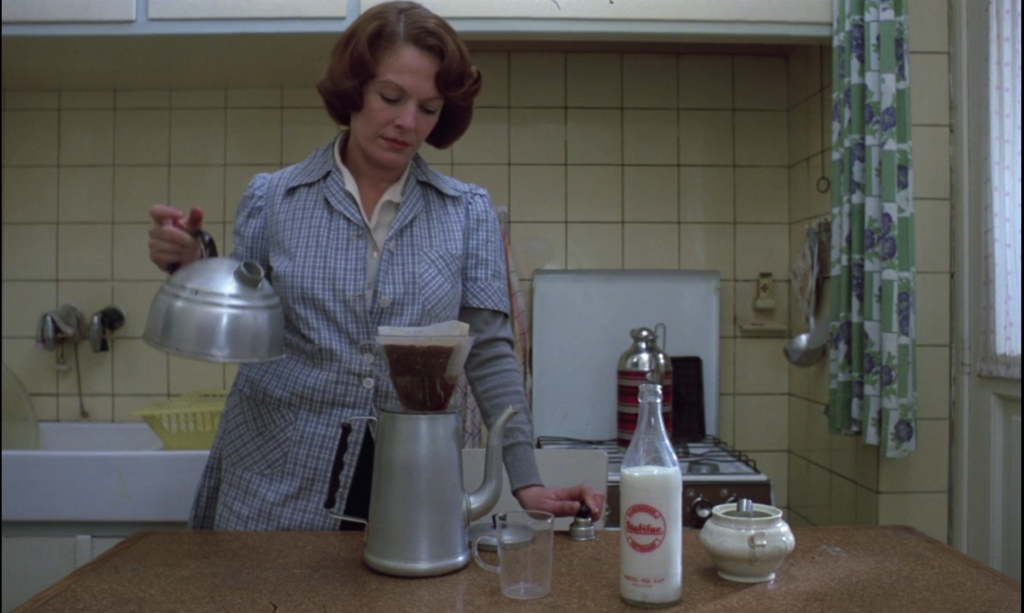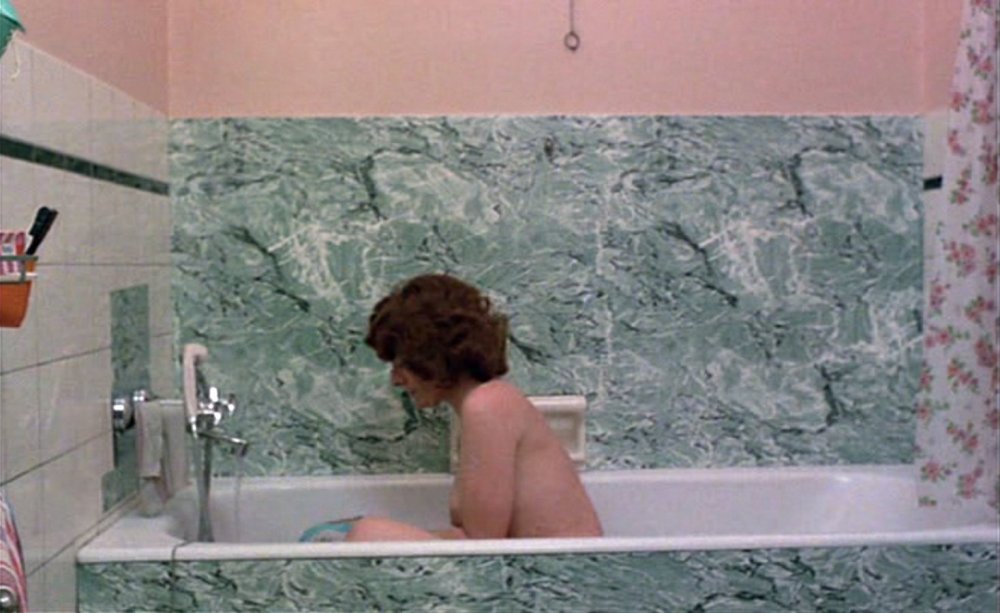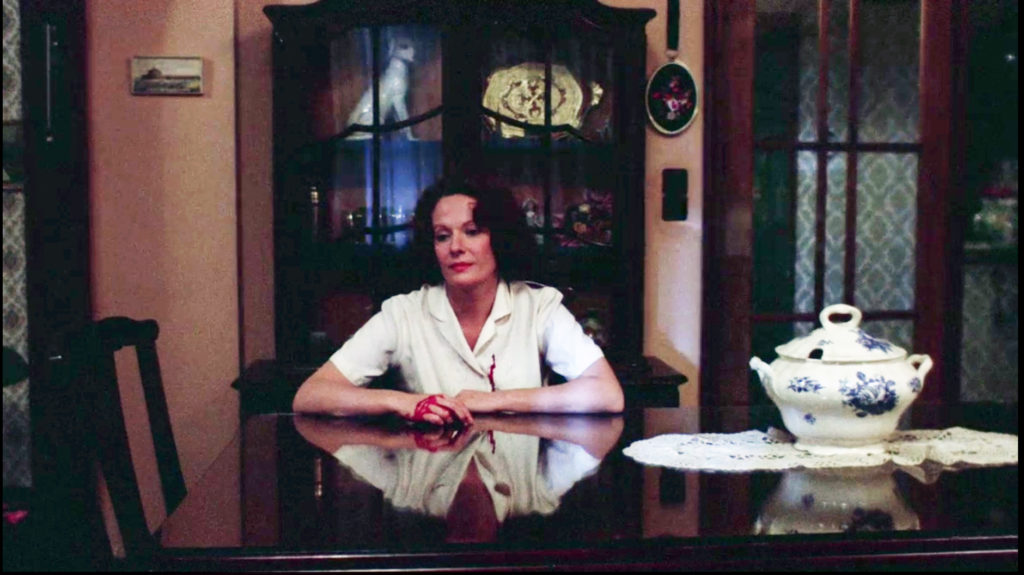Teaching Jeanne Dielman, 23 Quai du Commerce, 1080 Bruxelles
Patricia White
I’ve taught Jeanne Dielman, 23 Quai du Commerce, 1080 Bruxelles (Chantal Akerman, 1975), nearly every year for twenty-five years. While most students think of it as the kind of film you would see only if your professor made you, many later recognize it as the kind of film you get to see in college. Watching Chantal Akerman’s films as an undergraduate set me on my own professional path—by touching so deeply on the personal. This coalescing of meaningful life experience with properties of the film medium is precious to me as an educator. I believe it was precious to Akerman as a filmmaker.
The visceral comes first. At 3 hours 21 minutes, Jeanne Dielman is a commitment on the part of the viewer, especially if you aren’t watching it under ideal circumstances (i.e., the Criterion Blu-ray, projected on a large screen, in comfortable seating, with an audience that is prepared for something different). Unlike the bombast and cacophony typical of films of longer-than-usual length, it is made up of single takes of scenes that are lowest in what the director calls the “hierarchy in images”—a middle-aged, middle-class, stuck-in-mid-century, European woman washing dishes, making coffee, smoothing sheets—as it follows the breakdown of the protagonist’s daily routine.[1] Its sounds are sparing and punctual; you can also hear your neighbor’s fidgeting. It thus challenges what a movie is to look at and listen to, what cinema is as a way of bestowing attention. Like other time-based arts, Jeanne Dielman depends on rhythm; for a long time after watching it, I feel as if I am moving to a metronome.
Based on class discussions, which have become as consoling and revelatory for me in their repetition-with-a-difference as the ritual screening itself, students experience something similar: an awareness of the body at rest and in motion—looking at Jeanne, looking at the exit sign above the door; feeling like Jeanne, feeling like a stretch. This is not a gender-specific response, though my sample is heavily weighted toward the female-identified. (For those who care about such things, I make sure to share that Jeanne Dielman is tied for 35th place among the best films of all time in Sight and Sound’s authoritative poll.[2] And I lead them to question such things by pointing out it is the only film by a woman that makes the top 50.) Student responses have led me to realize that the patient, forgiving gaze that the film solicits is as filial as it is feminist.[3] Delphine Seyrig’s performance recalls the gestures of Akerman’s aunt and mother. And as Veda says in Mildred Pierce (1945): “everybody has a mother.” Not all mothers have the grace of Delphine Seyrig, of course, but even Roseanne slapping a box of cereal on the kitchen table can conjure the feeling of being at home that Jeanne Dielman draws out to such rare effect. Perhaps this is why college students, men and women, approach it with surprising tolerance—we sit and watch Jeanne cook, and no one’s asking us to get up and set the table.
Of course there are always haters. I assign a response paper to give students a chance to vent and, in so doing, to acknowledge how much the film got under their skin. Other students write about their mothers and grandmothers, taking for granted the elongated time of the film as fitting to its content. Others still provide self-reflexive accounts of watching without explicitly synching this awareness to the film’s depiction of the female quotidian. As our discussion of these papers unfolds I find myself giving a quick introduction to phenomenology. They have grasped through their bodies and testimonies the work of cinema in the age of information.
Jeanne Dielman can make a formalist out of anyone, and it is a great lesson for would-be filmmakers about how setting limits can inspire one’s best work. When I first taught the film on 16mm, we had no video to reference. I would ask students to go to the board and draw a single frame that sums up their memory of the film. The effort at recall focused our discussion, so I still use this exercise. Before we talk about the figures and objects in the frame, we talk about the box. Drawing the frame first helps students grasp the function of consistent camera distance in the film. Getting the proportions right helps them focus on the shape and presence of offscreen space. Jeanne Dielman has 223 shots averaging close to one minute each.[4] There is little to distinguish interstitial moments from the main action—Ivone Margulies’s chapter on the film is called the “equivalence of events”—and it is instructive to see the range of shots selected.[5] Jeanne with her back to the camera, washing dishes—a sign of repetition. Jeanne waiting for the water to run through the coffee filter, whose conical shape has been compared to an hour glass, as if she is pouring out time itself—a sign of duration.[6] Jeanne in the bathtub—a sign of ritual ablution. I eventually began supplementing the drawings with frame grabs, especially to discuss color: e.g. Jeanne’s pink skin against the bathroom tile.

Figure 1: Delphine Seyrig as Jeanne Dielman making coffee in real time—like sands through the hourglass. Jeanne Dielman, 23 Commerce Quay, 1080 Bruxelles (Chantal Akerman, 1975)

Figure 2: Jeanne Dielman in the bath, her skin matching the color of the walls. Jeanne Dielman, 23 Commerce Quay, 1080 Bruxelles (Chantal Akerman, 1975)
The last three shots of the film often show up in this exercise; if they don’t, I ask students to draw them on the board. Call them orgasm, murder, soup tureen.[7] We draw out some of the controversies that greeted the initial release and the debates over feminist/feminine aesthetics that they indexed. If the film is about the quotidian oppression of domesticity, why the titillation of prostitution and murder? Is Jeanne really feeling pleasure? Is this narrative closure? Inevitable comments on plot and character motivation have already been framed by our discussion of framing itself: the surprise of the novel camera set-up of the sex scene; its mirroring in the shot of Jeanne at the dressing table against the reflection of the heavy bed frame; the glimpse of the scissors just inside the frame; the return of the soup tureen as Jeanne’s double. This final seven-minute shot outlasts the two previous ones, and as it is slowly drained of narrative fullness, we are returned to the abstract elements of cinema: light moving in time, a seated body in reverie, breathing. Chalk drawings have their limits.

Figure 3: The film’s seven-minute long last shot, Jeanne doubled by the soup tureen. Jeanne Dielman, 23 Commerce Quay, 1080 Bruxelles (Chantal Akerman, 1975)
As the response papers attest, these lessons in phenomenology and aesthetics are realized through, not despite, the film’s feminist content and the inscription of the woman director’s perspective. This understanding deepens our ensuing discussions of Jeanne Dielman’s important place in film and feminist history and theory. In Film Theory, we’ve already watched Jean-Luc Godard’s 2 or 3 Things I Know about Her (1967), and adding a clip of Seyrig’s iconic performance in Alain Resnais’s Last Year at Marienbad (1961) facilitates a discussion of woman as sign in European art cinema (and in language and patriarchal culture more generally). I historicize feminist film culture and the debate over visual pleasure (the destruction of which is a mystifying prospect to them) and experimental form and prompt a discussion of why the ongoing gender inequity among directors is such a loss to the film experience.
In Feminist Film and Media Studies, we will have watched independent feminist documentary from the 1970s, which allows us to talk about realism and the authority of experience in US feminist politics in relation to the film’s subject matter and to introduce the contemporaneous French discourse of écriture feminine that informs the film’s silences and gestures. Sometimes the syllabus will be organized to historicize the question of feminist aesthetics through a comparison between Jeanne and the housewives of Germaine Dulac’s The Smiling Madame Beudet (1923), Dorothy Arzner’s Craig’s Wife (1936), and Laura Mulvey and Peter Wollen’s Riddles of the Sphinx (1977). We find the soup tureen’s analog in each of these films.
The scholarship on Jeanne Dielman holds its own aura as part of the launch and momentum of “cinefeminism” in the mid-1970s and revisiting it in the context of teaching is as rewarding for me as rewatching the film. There are two pieces I assign whatever the course: Janet Bergstrom’s influential essay on Jeanne Dielman, written “for the Camera Obscura collective” and published in 1977 in the journal’s second issue alongside excerpts from an interview with the director, identifies the film’s unique “logic of viewer/viewed,” director and character, feminist and feminine, in urgent and elegant prose.[8] In her magisterial 1985 essay “Aesthetic and Feminist Theory: Rethinking Women’s Cinema,” Teresa de Lauretis builds on this formulation to argue that the film “addresses the subject as a woman, regardless of the gender of its viewer.”[9]
It is this essay that led me to do my graduate work with de Lauretis, and it still informs my scholarship on contemporary women directors. I teach it most successfully when I have Akerman to back me up. De Lauretis writes: “What the film constructs—formally and artfully, to be sure—is a picture of female experience, of duration, perception, events, relationships and silences, which feels immediately and unquestionably true.”[10] I hope that the students get a similar feeling of immediate recognition from de Lauretis’s account of women’s cinema. “An aesthetic of reception, where the spectator is the film’s primary concern” is much more capacious than prescriptive formalism or message-driven realism.[11] One student, Brian Huser, certainly did, offering a description of Jeanne Dielman’s effect as “an unpredictable, even thrilling vulnerability on the part of the spectator,” in an essay on the film published in the undergraduate journal Film Matters. [12]
Over 25 years there are of course always new things to take into account when I teach Jeanne Dielman. Sofia Coppola, Todd Haynes, Kelly Reichardt, and Gus Van Sant pay homage to Akerman in their work. The art show and catalog WAC: The Feminist Revolution, recontextualizes her films in the 1970s feminist art movement.[13] Ivone Margulies’s brilliant Nothing Happens: Chantal Akerman’s Realist Everyday forever changed the terms of critical conversation on the director, and essays exploring the importance of Akerman’s Jewish identity and her family’s experience during the Holocaust extended early feminist accounts in crucial ways.[14]
Another seismic change was the film’s digitization. For years showing Jeanne Dielman each year was an event: securing the rental budget to get the ever more scratched up 16mm print from New Yorker Films, publicizing it widely to justify the costs. Once I had to check out the circulating print from the New York Public Library to schlepp to Pennsylvania. I still make a ritual out of the screening, arranging the syllabus so I teach it around my birthday. I eagerly ordered the European DVD set for myself and friends when it became available and later snapped up the Criterion version. The remastering showed so much new detail–as if sensitized by Jeanne’s OCD, I found the pattern on the dishtowel almost provocative. And promiscuous dispersion of the film’s images online seemed a violation of its durational integrity. But oh, the color: Seyrig’s mahogany hair, the pink baby bootie popping into view like something out of a horror film. And the DVD extras include Sami Frey’s “making of” film Autour de Jeanne Dielman (1975), with an astonishingly young Akerman describing exactly what she wants from her diva. Most importantly the digitization makes it possible to quote Jeanne Dielman. In the videographic essay Time on My Side, one student, Anita Castillo Halvorssen, makes up for subjecting the film to external montage by making its long takes her focus.[15]
But the most irreversible change to reckon with when teaching the film has been Akerman’s death. I woke up on October 6, 2015 to a birthday message that shared the tragic news. I was to teach Jeanne Dielman that very day in Feminist Film; we had had our class screening the night before. I spent my commute tearfully contemplating what to say to my students. I ended up talking about what Akerman meant to me and showing a scene that exemplified the sense of intimacy I felt with a filmmaker whom I had met a handful of times but was too intimidated to say much to: the lesbian sex scene from Je tu il elle (1974). It was a little uncomfortable showing it in class—Akerman later said she might not have acted in it herself if she’d realized how “strong” it would be— but we had already been through a lot together.[16] Witnessing this strength reconnected me to Chantal’s love as well as her loss. The students’ response that year, and the many notes I received from former students when they heard the news, resonated with the youthful brilliance and vulnerability of Akerman’s work.
The flood of memorial writing after Akerman’s death put me off at first; later, it fed me. I was nourished in particular by the beautiful ways women wrote about how “immediately and unmistakably true” her work felt to them.[17] I am currently working on editing a Camera Obscura tribute issue. But it seems fitting to write about Akerman here in the context of a teaching dossier. Students have told me over the years that the film was one of the most meaningful that they encountered in their film education—an unforgettable, sense-memory implanting experience. Jeanne Dielman is about routine and rupture, deep love and risk-taking—so is teaching.
Patricia White is Eugene Lang Research Professor of Film and Media Studies at Swarthmore College. She is author of Women’s Cinema/World Cinema: Projecting Contemporary Feminisms (Duke UP, 2015) and Uninvited: Classical Hollywood Cinema and Lesbian Representability (Indiana UP, 1999) and co-author, with Timothy Corrigan, of The Film Experience (Bedford St Martins, 5th ed., 2018). She is a member of the editorial collective of the journal Camera Obscura: Feminism, Culture, and Media Studies and its book series with Duke UP.
Notes
[1] Chantal Akerman, “I do think it’s a feminist film because I give space to things which were never, almost never, shown in that way, like the daily gestures of a woman. They are the lowest in the hierarchy of film images. A kiss or a car crash come higher…. It is because these are women’s gestures that they count for so little,” “Chantal Akerman Interview with Camera Obscura,” Camera Obscura 2 (1977): 118.
[2] Sight and Sound Contributors, “The 50 Greatest Films of All Time,” Sight and Sound (September 2012), http://www.bfi.org.uk/news/50-greatest-films-all-time.
[3] Judith Mayne describes it thus: “the daughter’s perspective is…a vantage point from which to revise substantially just what the primal scene is, psychically and cinematically, for women, Woman at the Keyhole: Feminism and Women’s Cinema (Bloomington: Indiana UP, 1990), 210.
[4] For number and duration of shots, see the Cinemetrics website http://www.cinemetrics.lv/database.php.
[5] Ivone Margulies, Nothing Happens: Chantal Akerman’s Hyperrealist Everyday (Durham: Duke UP, 1996), chapter 3.
[6] Margulies cites Thierry de Duve’s reading of this gesture, Nothing Happens, 78.
[7] See Laura Mulvey’s beautiful reading of melodrama and mise-en-scène in the film, “A Neon Sign, a Soup Tureen: the Jeanne Dielman Universe,” Film Quarterly 70.1 (Fall 2016): 25-31.
[8] Janet Bergstrom, “Jeanne Dielman: 23 Quai du Commerce, 1080 Bruxelles,” Camera Obscura 2 (1977): 117.
[9] Teresa de Lauretis, “Aesthetic and Feminist Theory: Rethinking Women’s Cinema,” New German Critique 34 (Winter 1985): 161.
[10] de Lauretis, 159.
[11] de Lauretis, 170.
[12] Brian Huser, “‘Returning the Look’: Spectatorship and Feminist Aesthetics in Jeanne Dielman,” Film Matters (Summer 2012): 16-20.
[13] Cornelia Butler, WACK! Art and the Feminist Revolution (Cambridge, MA: MIT Press, 2007).
[14] See Gwendolyn Audrey Foster, ed., Identity and Memory: The Films of Chantal Akerman (Trowbridge, Wiltshire: Flicks Books, 1999); Kathy Halbreich and Bruce Jenkins, Bordering on Fiction: Chantal Akerman’s D’Est (Minneapolis: The Walker Arts Center, 1995); and Alisa Lebow, “Memory Once Removed: Indirect Memory and Transitive Autobiography in Chantal Akerman’s D’Est,” Camera Obscura 52 (2003): 35-82.
[15] Anita Castillo-Halvorssen, Time on My Side, https://vimeo.com/125911351 linked in Catherine Grant, “Female Videographic Criticism Producers,” https://filmstudiesforfree.blogspot.com/2017/03/videographic-screen-media-criticism-by.html.
[16] Chantal Akerman and Angela Martin, “Chantal Akerman’s Films: A Dossier,” Feminist Review 3 (1979): 30.
[17] For some of this moving writing, see the dossier edited by Bérénice Reynaud, “In Memoriam—Chantal Akerman: La Passion de l’Intime/An Intimate Passion,” Senses of Cinema (December 2015), http://sensesofcinema.com/2015/chantal-akerman/introduction-chantal-akerman-an-intimate-passion/ and the dossier edited by B. Ruby Rich and Ivone Margulies in Film Quarterly 70.1 (Fall 2016).
